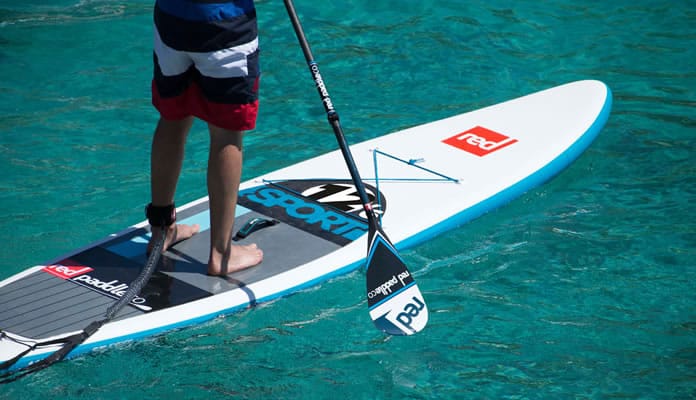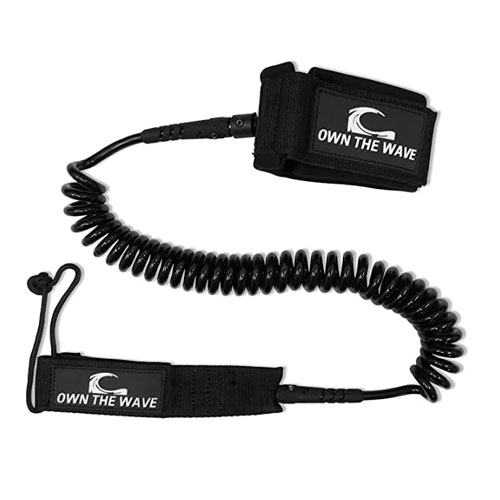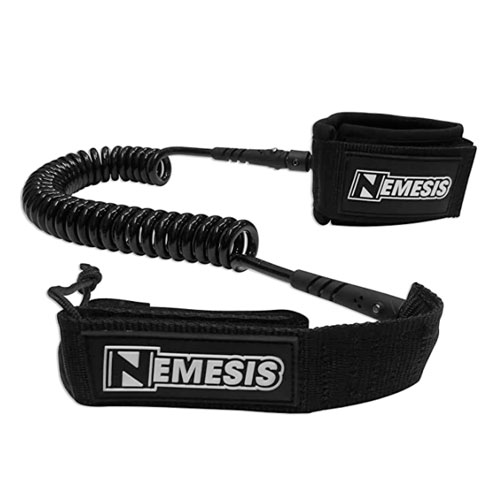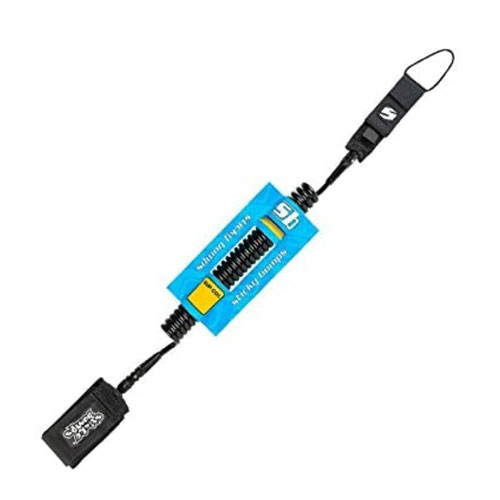
Even though it doesn’t happen frequently on a SUP, getting wiped out or losing balance is not unheard of. If you end up in the water, getting separated from your board can make things even worse. Unless you want to swim after it or chase it to the shore, it’s smart to wear the best paddle board leash you can afford.
Usually made from neoprene, these leashes feel comfortable on your ankle and allow full freedom of movement. However, in case you fall, they will make sure that the board stays close to you.
While they might look similar, the differences in length and material quality significantly impact how they perform on the water. In this article, you’ll learn about all of their features and discover the best SUP leashes to keep you safe every time you hit the water.
Santa Barbara Surfing SBS SUP
- Stand Out Features - Why We Love It
- 316 stainless steel swivels won’t rust
- Triple rail saver prevents wear on the rail
- Extra-strong to handle heavy and long boards
- Free replacement if you have any issues
Length (Extended): 10 feet
Cord Thickness: 7 millimeters
Cord Material: Urethane
Cuff Material: Neoprene
A ALPENFLOW Coiled
- Stand Out Features - Why We Love It
- Great-looking color options (blue, green, orange, pink)
- Flexible and lightweight TPU cord
- Padded neoprene cuff for ankle comfort
- Triple-wrap rail saver made of high-density nylon
Length (Extended): 10 feet
Cord Thickness: 7 millimeters
Cord Material: Thermoplastic Polyurethane
Cuff Material: Neoprene
Airhead Scrunchy
- Stand Out Features - Why We Love It
- Accordion-style webbing for extra durability
- Swivels at the ends prevent kinks and tangling
- Extra-long when stretched (11 feet)
- One of the lightest ankle leashes available
Length (Extended): 11 feet
Cord Thickness: 7 millimeters
Cord Material: Accordion-Style Webbing
Cuff Material: Neoprene
Sticky Bumps Stand Up
- Stand Out Features - Why We Love It
- Comes in four sizes ranging from 9 to 12 feet
- 38-millimeter neoprene cuff provides comfort
- Extra-thick urethane leash cord (8mm)
- Hook and loop closure for easy setup
Length (Extended): 9, 10, 11, and 12 feet
Cord Thickness: 8 millimeters
Cord Material: Urethane
Cuff Material: Neoprene (38mm wide)
How To Choose A Paddle Board Leash – Buying Guide

Types of SUP Leashes
Depending on your preferences and stand up paddle board design, three types of SUP leashes are available – coiled, straight, and hip leash. The most popular option is certainly the coiled leash, but the other two options also have something to offer.
Coiled Leash: As its name suggests, this leash is tightly coiled by default. Because of this, it’s the best SUP leash if you want to avoid tangling and dragging in the water.
Straight Leash: When it comes to freedom of movement while paddle boarding, a straight leash doesn’t have any competition. It allows you to adjust your feet quickly, which is why it’s very popular in paddle board racing.
Hip (Waist) Leash: A hip leash is a great option if you have any problems with your legs. Regardless of its different position, it does an equally good job as an ankle or calf leash.
You might also like: Nixy Carbon Fiber Paddle
Length
As a rule of thumb, the leash should be at least as long as your board (maybe a bit longer). In practical terms, if you have a 10-foot SUP it’s ideal to go with an 11-foot leash. If the leash is too short, it might pull the board when you fall so it hits you. If it’s too long, it will tangle often and drag in the water.
Material Quality
For optimal performance, the best combination of materials is a neoprene cuff and a TPU cord. The neoprene feels great on the skin and doesn’t cause irritation, while TPU has the strength to withstand large forces when you fall.
FAQs

Q: Why Should You Use A SUP Leash?
By wearing a leash, you ensure that you don’t lose your stand up paddle board when you fall off. In addition to keeping the board close, a leash will also help you pull it when you want to climb back on.
Q: What Are The Parts Of A SUP Leash?
The main parts of a SUP leash are the cuff, swivel, cord, rail saver, and leash string. Here’s a couple of words about each of them so you better understand their function.
- Cuff: The part that goes around your ankle or calf, keeps you attached to the board
- Swivel: Metal part that connects the cuff and cord, prevents tangling
- Cord: Strongest part of the leash, connects the cuff to the rail saver
- Rail Saver: Piece of webbing that protects the board from damage when the cord is tightened
- Leash String: Heavy-duty string that is tied directly to the board’s leash plug
Q: What is The Difference Between A SUP Leash and a Surf Leash?
The main difference is the design – SUP leashes are usually coiled, while surf leashes are generally straight. In addition, SUP leashes are often a bit longer compared to surf models.
Q: What Leg Does The Leash Go On?
While it doesn’t make too big of a difference, many paddleboarders will choose to put the leash on their dominant leg (rear leg). Because this leg is usually stronger and better coordinated, your overall feeling while paddle boarding is improved.
Globo Surf Overview
After a life vest, a SUP leash is the second most important piece of safety equipment that you need. We hope that our guide and reviews have pointed you in the right direction, so you can get the best SUP leash that will be both comfortable and reliable.
Paddle boards Gear Reviews:












